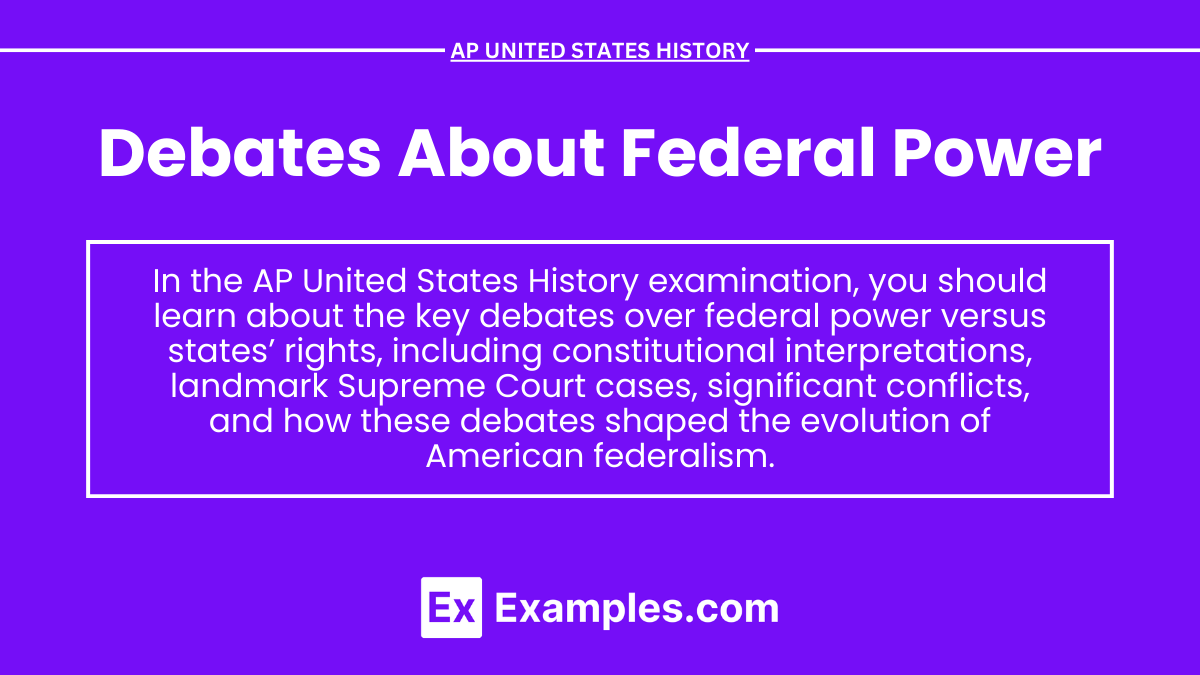In AP United States History, debates about federal power are central to understanding the development of American government and politics. From the nation’s founding, conflicts between those advocating for a strong central government and those championing states’ rights have shaped the U.S. Constitution, influenced landmark Supreme Court decisions, and driven major political conflicts. These debates, ranging from the early Federalist-Anti-Federalist disputes to modern issues over federal authority, have continually defined the balance of power between the national government and the states.
Learning Objective
In studying debates about federal power for AP United States History, you will be expected to understand the historical conflicts between federal authority and states’ rights. The significance of key events, court cases, and political disputes that shaped the balance of power will be analyzed. You will also be able to evaluate how these debates influenced constitutional interpretation, governance, and the evolution of federalism in the United States, reflecting broader ideological, economic, and regional differences throughout American history.
The Constitutional Convention and the Origins of Federal Power

- Federalists vs. Anti-Federalists (1787-1788): The debate over ratification of the U.S. Constitution highlighted the first major conflict over federal power. Federalists, led by figures like Alexander Hamilton and James Madison, supported a strong central government to ensure stability and unity. Anti-Federalists, including Thomas Jefferson and Patrick Henry, opposed the Constitution, fearing that a powerful federal government would infringe on states’ rights and individual liberties. The compromise led to the adoption of the Bill of Rights to protect individual freedoms.
Early Republic and the Strengthening of Federal Power
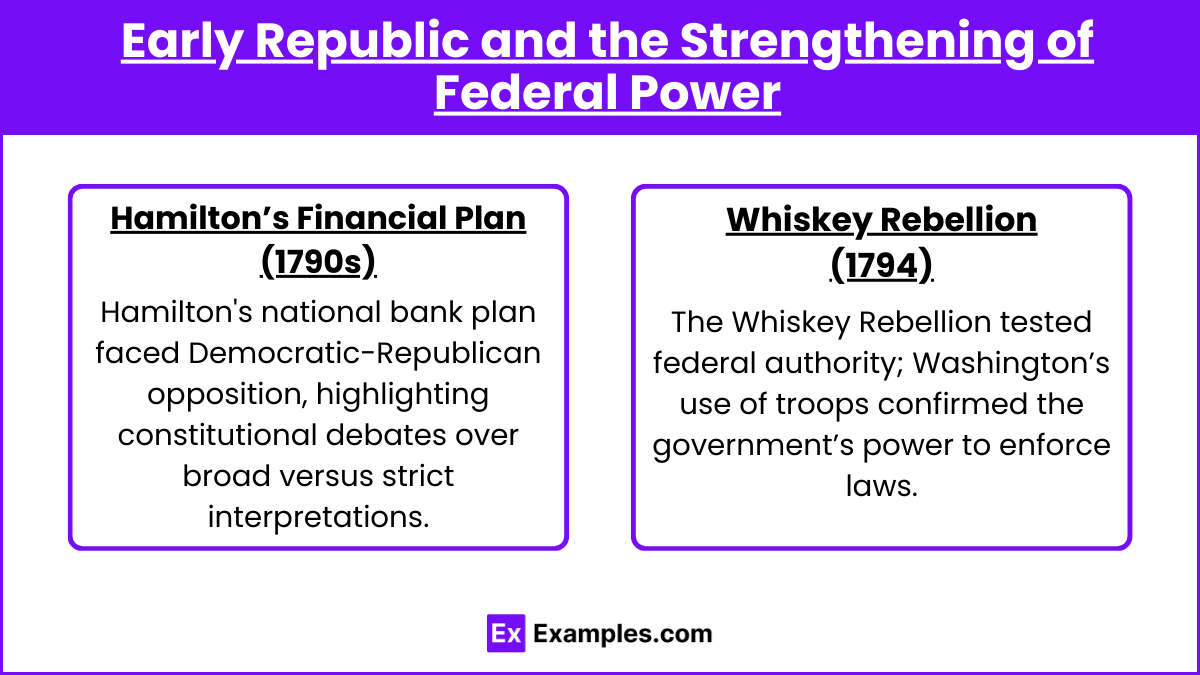
- Hamilton’s Financial Plan (1790s): Alexander Hamilton’s plan to establish a national bank, assume state debts, and implement tariffs sparked significant opposition from Democratic-Republicans, who believed it overstepped federal authority. The debate over the constitutionality of the national bank highlighted differing interpretations of the Constitution—broad (implied powers) versus strict (enumerated powers).
- Whiskey Rebellion (1794): A domestic uprising in response to Hamilton’s excise tax on whiskey tested federal authority. President George Washington’s decisive use of federal troops to suppress the rebellion demonstrated the power of the federal government to enforce laws and maintain order.
The Marshall Court and Judicial Strengthening of Federal Power
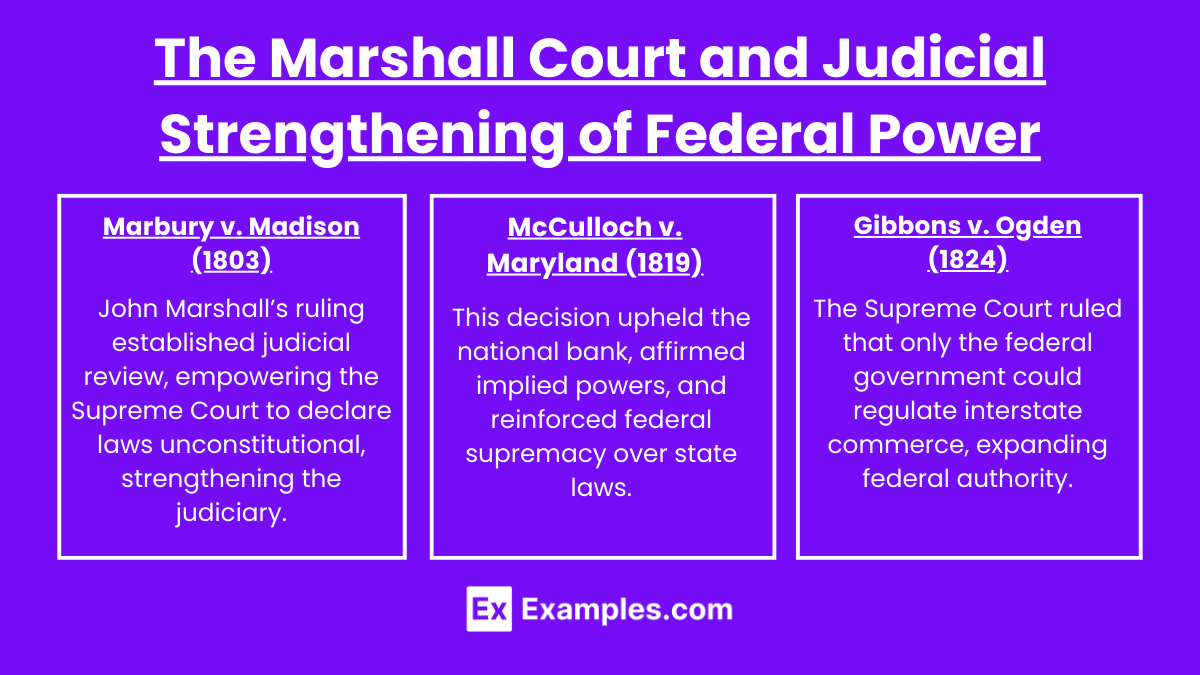
- Marbury v. Madison (1803): Chief Justice John Marshall’s ruling established the principle of judicial review, giving the Supreme Court the power to declare federal laws unconstitutional. This case significantly strengthened the judiciary’s role in balancing federal power.
- McCulloch v. Maryland (1819): This landmark decision upheld the constitutionality of the national bank and reinforced the doctrine of implied powers, affirming that federal laws take precedence over state laws. The case emphasized the supremacy of federal power over state governments.
- Gibbons v. Ogden (1824): The Supreme Court ruled that the federal government had the exclusive power to regulate interstate commerce, further expanding federal authority at the expense of state power.
The Civil War and Reconstruction
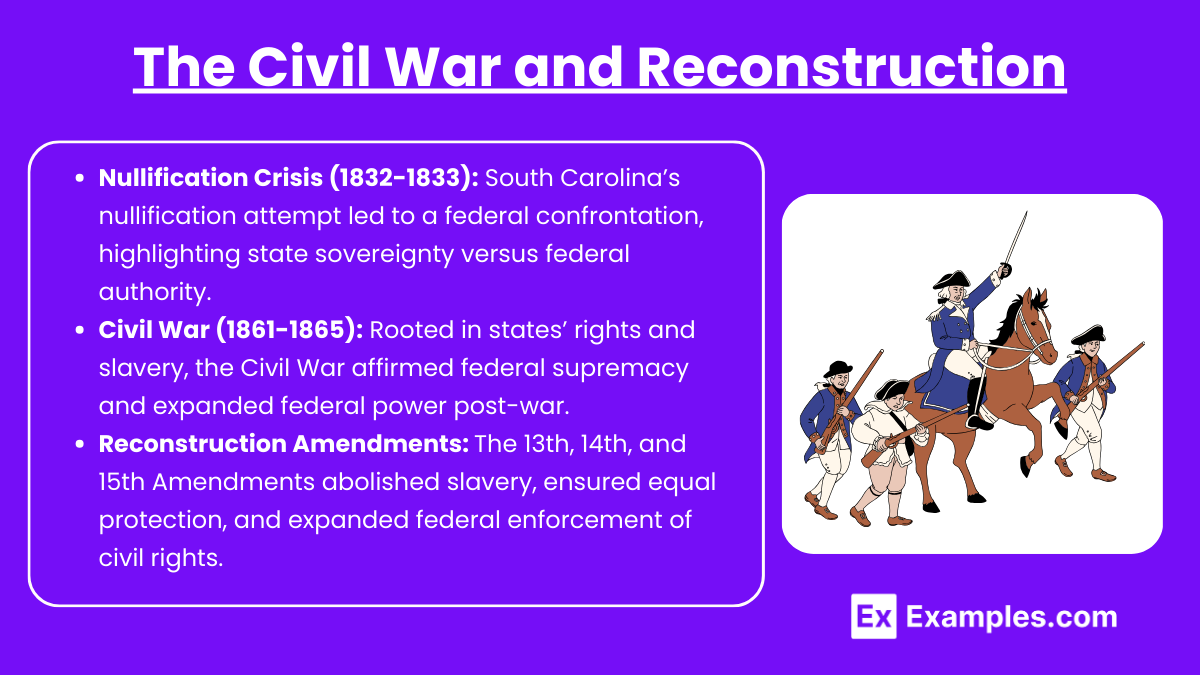
- Nullification Crisis (1832-1833): South Carolina’s attempt to nullify the federal Tariff of 1828 led to a confrontation with President Andrew Jackson, who asserted federal supremacy by threatening military action. The crisis highlighted the ongoing struggle between state sovereignty and federal authority.
- Civil War (1861-1865): The secession of Southern states and the subsequent Civil War were rooted in disputes over states’ rights and federal power, particularly concerning slavery. The Union’s victory established the supremacy of the federal government and led to significant expansions of federal power during Reconstruction.
- Reconstruction Amendments (13th, 14th, and 15th): These amendments abolished slavery, guaranteed equal protection under the law, and protected voting rights, significantly increasing federal power to enforce civil rights.
The 20th Century and Modern Debates
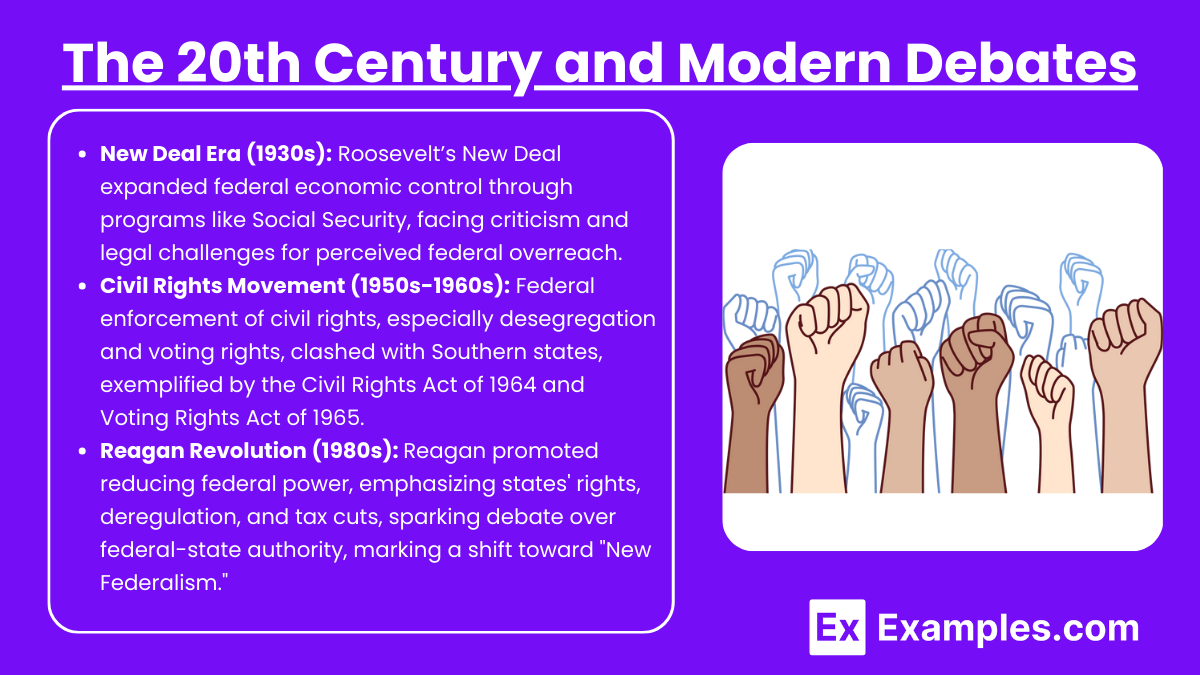
- New Deal Era (1930s): In response to the Great Depression, President Franklin D. Roosevelt’s New Deal expanded the federal government’s role in the economy through programs like Social Security and regulatory agencies. Critics argued that the New Deal represented an overreach of federal power, leading to significant legal challenges.
- Civil Rights Movement (1950s-1960s): The federal government’s role in enforcing civil rights, including desegregation and voting rights, led to conflicts with states, particularly in the South. Key legislation like the Civil Rights Act of 1964 and the Voting Rights Act of 1965 underscored the federal government’s power to protect individual rights.
- Reagan Revolution (1980s): President Ronald Reagan championed a reduction in federal power, advocating for states’ rights, deregulation, and tax cuts. This era sparked a renewed debate over the balance between federal and state authority, often described as a shift toward “New Federalism.”
Examples
- The Kentucky and Virginia Resolutions (1798-1799): These resolutions, authored by Jefferson and Madison, argued that states had the right to nullify federal laws they deemed unconstitutional, challenging the Alien and Sedition Acts and asserting states’ rights over federal authority.
- The Nullification Crisis (1832-1833): South Carolina’s nullification of federal tariffs and the subsequent conflict with President Andrew Jackson highlighted the tension between federal authority and states’ rights.
- McCulloch v. Maryland (1819): Established the principle of implied powers and reinforced federal supremacy over the states, particularly in the realm of economic regulation.
- The Civil Rights Act of 1964: This landmark legislation expanded federal power to enforce civil rights, overriding state laws that supported segregation.
- The Affordable Care Act (2010): The debate over the constitutionality of the ACA, particularly the individual mandate, reignited discussions about the limits of federal power and states’ rights in modern America.
Multiple-Choice Questions (MCQs)
1. The principle of judicial review, which strengthened federal power by allowing the Supreme Court to declare federal laws unconstitutional, was established in which case?
- A. Gibbons v. Ogden
- B. Marbury v. Madison
- C. McCulloch v. Maryland
- D. Dred Scott v. Sandford
Answer: B. Marbury v. Madison
Explanation: The 1803 decision in Marbury v. Madison established judicial review, allowing the Supreme Court to assess the constitutionality of federal laws, thereby enhancing federal power.
2. The Nullification Crisis of 1832-1833 was primarily a conflict between:
- A. Federal authority and the Supreme Court
- B. State sovereignty and federal tariffs
- C. The federal government and Native American tribes
- D. The executive branch and the legislative branch
Answer: B. State sovereignty and federal tariffs
Explanation: The Nullification Crisis arose when South Carolina attempted to nullify federal tariffs, challenging federal authority and asserting state sovereignty.
3. Which of the following was a key outcome of McCulloch v. Maryland (1819)?
- A. The establishment of the U.S. as a global power
- B. The confirmation of the federal government’s implied powers
- C. The expansion of judicial review
- D. The restriction of interstate commerce
Answer: B. The confirmation of the federal government’s implied powers
Explanation: McCulloch v. Maryland upheld the constitutionality of the national bank and affirmed that the federal government has implied powers under the Necessary and Proper Clause, reinforcing federal supremacy.

